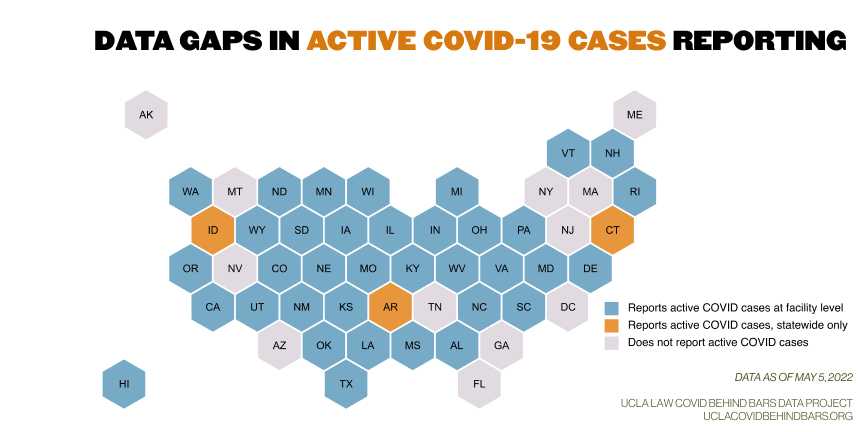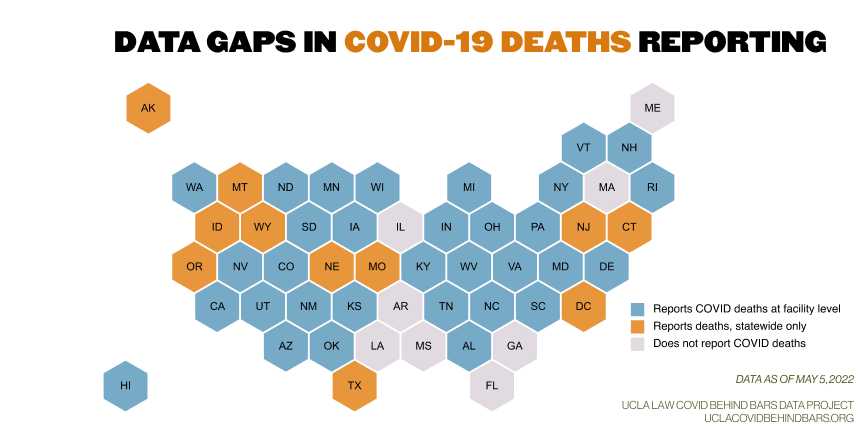May 9th, 2022 • Lauren Woyczynski and Joshua Manson
What We Won't Know When the Next Surge Arrives
As public health experts predict new COVID surges in the coming weeks, incarcerated people are, again, at heightened risk for COVID infection and death.
But still, even two years into the pandemic, there are enormous gaps in what the public will know about its spread behind bars.
Although the deadly toll of COVID on people in prisons, jails, and immigration detention facilities is by now well-documented, carceral agencies continue to block swaths of critical information from the public about the state of COVID among people in their custody and their staff.
Today, eleven states and Washington, D.C. — representing 21 percent of the country’s total prison population — report no data on the number of active COVID cases among people in their custody. Three more states report active cases, but only statewide and not by facility.

21 states report no data about the number of active COVID cases among staff and six more only report statewide.
Today, eight states do not even report how many people have died of COVID in their custody. Together, these eight states hold 18 percent of the total prison population nationally.

Many prison agencies that do ostensibly report data are reporting significantly outdated numbers. In addition to the 12 agencies that report no data on active COVID cases among people in their custody, for instance, four more claim to report this data, but their dashboards show data that are more than a month old:
- The Washington DC DOC presented daily data updates until February 22, 2022, but has not reported a single update since then.
- The Iowa Department of Corrections last updated its website on February 23, 2022.
- The South Dakota Department of Corrections’ last data update occurred on March 8, 2022.
- The Utah Department of Corrections’ last update was on March 14, 2022.
- The Mississippi Department of Corrections publishes data on cumulative cases and active cases, but has gone months without updating either (during the height of the national Delta outbreak, the state did not update its data once).
***
Over the course of the pandemic, carceral agencies have, by and large, only become less transparent, not more. In fact, as we noted in our previous scorecard update, we assigned more agencies failing scores this round than ever before.
Several agencies stopped reporting COVID data last spring and summer, obscuring from public view the true toll of the virus during the Delta and Omicron waves to come:
- The New Jersey Department of Corrections has not updated its COVID dashboard since May 26, 2021.
- The Florida Department of Corrections stopped reporting all COVID data on June 2, 2021.
- On June 15, 2021, the Massachusetts Department of Corrections stopped providing all COVID data, citing the expiration of a court-ordered data reporting mandate.
- The Texas jail system, which houses around 55,000 people, stopped reporting all data on June 19, 2021.
- The Georgia Department of Corrections abruptly removed its COVID tracking dashboard on July 19, 2021.
Even after the recent Omicron surges, however, agencies continued to roll back transparency measures. Just last month, the Tennessee Department of Correction, which has seen at least 8,000 cases among people incarcerated in state prisons, suddenly stopped reporting all COVID data except deaths from its prisons.
As a result, during the likely wave of infections to come, we’ll know even less about COVID behind bars than we did during the Delta and Omicron outbreaks of 2021. Public health responses will be inhibited, but so will efforts to hold agencies accountable for the outbreaks that occur in their facilities. In October 2021, the Tennessee Lookout reported on soaring COVID rates in Tennessee’s privately run prison facilities as compared to lower rates in state-run facilities. Today, because the state has since removed from its website all information on COVID cases in its prisons, that reporting may no longer be possible.
There’s no guarantee that these transparency rollbacks won’t continue, nor that the limited data currently available will remain public during likely surges to come. Without legislative requirements or accountability to state officials, prison systems and the vast majority of jail systems are free to stop reporting COVID data at any time, including immediately before anticipated outbreaks.
There is no reason that carceral agencies should become less transparent over time, rather than more. In fact, not all have. In October 2021, the Rhode Island Department of Corrections only reported cumulative cases and deaths. It has since, however, added active COVID cases and percent of incarcerated people fully vaccinated, two vital metrics for adequate COVID surveillance, to its regular data reports.
As infections and deaths are likely to increase again, transparency and accountability are as critical as ever. Rather than rolling back the basic reporting measures that have been put in place, carceral agencies should build on incremental progress toward transparency and expand data reporting. The COVID data reporting that has occurred during the pandemic should be the floor and not the ceiling for informing the public about what is happening inside prisons, jails, and detention centers. It should serve as a foundation for future data transparency and not a temporary emergency practice.
next post
May 25th, 2022 • Aparna Komarla, Covid In-Custody Project
In California jails, sheriffs have been left in charge of COVID mitigation. The results have been disastrous.
In California and across the country, health officials have taken a backseat in addressing the COVID pandemic in county jails. In their absence, it's been local sheriffs who have been left in charge.